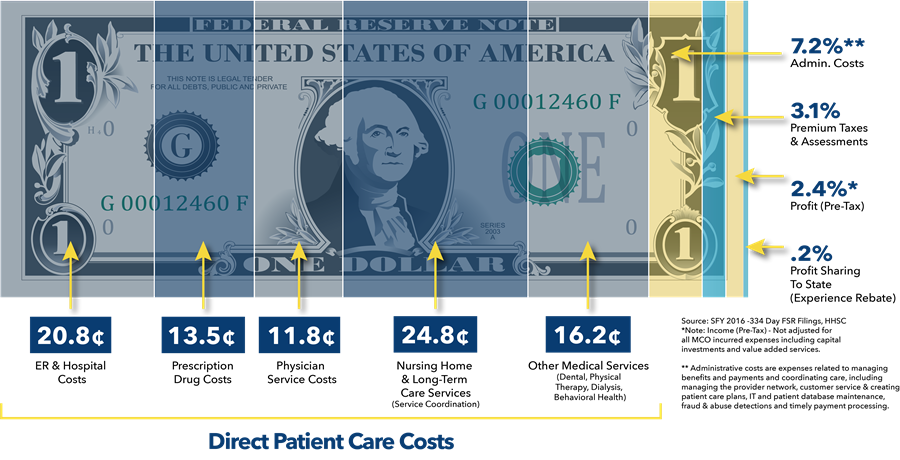“Over the past almost 15 years, MCOs have been able to successfully bend the Medicaid cost curve”
The Texas Conservative Coalition Research Institute has released a policy white paper, Evaluating the Cost-Effectiveness of Medicaid Managed Care, which examines the managed care model in Texas and concludes that this model has contained costs for Texas, even as the program has seen record growth:
- “When Medicaid caseloads grew by 93 percent between fiscal years (FY) 2002–2016, per member per month (PMPM) Medicaid costs increased only by a total of 17 percent, or just over one percent per year on average.”
To help analyze data, TCCRI procured the services of Carruth & Associates, an independent outside firm headed by the former Chief Financial Officer of HHSC. See Carruth’s graph below.
Medicaid Managed Care Keeps Cost Growth Flat
Containing Costs While Improving Quality
The TCCRI report highlights how the managed care model has not only contained costs, but has also greatly improved the quality of care Texans are receiving:
- “While that report, and this paper, will focus primarily on cost savingsassociated with Medicaid managed care, this model has also shown great success in raising the quality of care for Medicaid enrollees. The Carruth & Associates report notes, “[c]ost-[e]ffectiveness is only achieved, in the long-run, through a program that delivers high quality at the lowest cost possible to maintain the value.” A true measure of a system’s cost-effectiveness does not simply examine the input (i.e. state funds being put into the Medicaid program), but also the output (i.e. the quality of care and health outcomes of enrollees being served).
- “Over the past almost 15 years, MCOs have been able to successfully bend the Medicaid cost curve while only controlling a portion of the Medicaid budget. Today, about 70 percent of the total Medicaid spend is within capitation.
- “Periods of significant growth in managed care tend to correspond with very low Medicaid PMPM cost growth, and in some cases, even declines:
- From FYs 2012–2016, after the state underwent a large statewide managed care expansion, overall caseloads increased by 11 percent, while total Medicaid costs increased by 17 percent.
- However, Medicaid PMPM costs increased by less than 1 percent per year, while national health expenditures during this same time period experienced almost four percent per capita growth.”
“Medicaid managed care has been demonstrated as one of the most effective means of bending the ever-increasing Medicaid cost curve and providing high-quality health care coverage.”
-Texas Conservative Coalition Research Institute, March 2018
Strong Oversight & Fiscal Responsibility
Also included in the TCCRI report is an overview of HHSC’s oversight of MCOs and how each Medicaid dollar is spent:
- “As part of its inclusive supervision, HHSC monitors all aspects of an MCOs business and operations, from the robustness and availability of provider panels, how long it takes enrollees to schedule appointments, and the quality of services provided, to the plan’s fiscal soundness and staff turnover; HHSC also assesses contractual remedies, including corrective action plans and liquidated damages, when appropriate. The state places a cap on the amount of money that MCOs may use towards administrative expenses, places a percentage of a health plan’s premium at risk to ensure certain client quality metrics are met, and enforces a strict limit on the amount of profit these plans can make from Medicaid and CHIP business. Any profit that exceeds this threshold is recovered by the state through an experience rebate process.”
The following graphic included in the TCCRI report provides a visual depiction of how a dollar within the Medicaid managed care system is spent.
How a Medicaid Dollar is Spent
Nearly 90% Invested Directly in Patient Care
“Since its inception as a small pilot program in the 1990’s, Medicaid managed care has grown into one of the state’s most successful initiatives, allowing Texas to utilize private sector businesses and free market innovation to better deliver government-sponsored programs.”
-Texas Conservative Coalition Research Institute, March 2018
Managed Care Model Relies on Right Care, Right Time
The TCCRI report concludes:
- “This point cannot be overstressed- while detractors of managed care allege that cost savings are reached simply by denying or rationing care, the model actually relies on ensuring that enrollees receive the right care, at the right time, and in the right setting, and the data supports this fact.”
“As lawmakers further explore the Medicaid managed care model in coming interim committee hearings and form recommendations for the 86th Legislative Session, it is imperative that state leaders continue to fully embrace this model and reject policies that would hinder an MCO’s ability to continue providing higher-quality cost-effective care to the state’s Medicaid and CHIP populations.”
-Texas Conservative Coalition Research Institute, March 2018
To read the full report, click here.
Share on Twitter!
Click to Tweet: @UHC #STARKids #Medicaid managed care plan helped Jordan Scott of #McAllen, TX with cerebral palsy navigate ADA challenges at his high school. Today, he travels seamlessly to classes. http://valleycentral.com/news/local/insurance-company-works-with-mcallen-school-to-accommodate-student #txlege #MedicaidMatters #MedicaidMonday
